Passive filters
updated: Apr-19-2024
What possible benefits do these filters offer over (digital) EQ
Passive filters can be handy when (exact) digital parametric EQ is not available. For instance when using headphones with analog sources or portable sources that do not have parametric EQ.
Parametric EQ is an equalizer with a few filters of which the center frequency as well as the steepness (Q) of the filter and attenuation can be set separately. This is not the same as ‘graphic EQ’ which is a multiband equalizer with fixed frequency bands, fixed bandwidths where one can only set + or – certain dB’s.
Or when it is easier to just be able to plug in the headphone in various gear but still have a treble peak removed. Say in a studio or home with a few different headphone outputs that are sometimes used.
Or when more than 1 headphone is used (now and then) and one does not want to switch EQ presets or presets are not available.
What is the downside of a filter
It is mounted between the source (headphone out of a device) and the headphone cable so takes up space, is not small nor very lightweight and adds 2 connectors (1 male and 1 female).
Filters sometimes can not be used in combination with high output resistance headphone outs.
In such cases, where low impedance (< 64Ω) headphones are used, this could be an issue.
For higher impedance headphones a higher output resistance is not an issue. Ask if unsure.
Parametric EQ is free or costs very little. The costs of a filter consist of the needed connectors and shipping costs.
Can I also replace a cable by a cable with a filter in it ?
In some cases, yes but only when the headphone uses some standard connector in the headphone itself.
Each filter is purpose made for a specific headphone (see list below) and can NOT be used for other headphones. There thus is no ‘universal’ filter.
Passive filters can ONLY attenuate. (Substantial) peaks in frequency response are far more sound degrading than dips. This is what these filters do they remove emphasis and bring it down to the proper level.
Also passive attenuators can be made (and ordered) this way in any attenuation between -10dB to -25dB attenuation custom to your specific needs/IEM.
The picture below shows some examples (more variations/connectors possible) of what built filters can look like.
These are not the only possible configurations, these are just a few examples !

The filters are custom built so it may take a few days before I have time to make you one. It could take up to a week before it can be shipped. Parts may not always be on stock which can increase the waiting period before it is delivered.
There is no obligation to buy when contacting me.
Since I buy parts in small quantities from E.U. sellers and everything is hand-built by me I cannot offer these filters for Chinese-made prices alas nor offer Chinese shipping costs.
Depending on the used connectors and shipping method and destination expect the total price of a filter (incl. shipping) to be somewhere between €35.- and €60.-
I can now also make headphone extension cables and conversion cables
Conversion cables can be handy when a headphone and the music source/amplifier have a different type of connector. Not all conversion cables are possible so please ask if a conversion cable is possible.
Conditions:
Cables and available in red, blue, or black. No other cable brands types than the ones that are in stock are available, also not on request.
or black. No other cable brands types than the ones that are in stock are available, also not on request.
Various lengths can be ordered, the minimum length is 25cm to depending a little on the used connectors. Maximum length (for high impedance headphones) = 4m. Balanced filters/attenuators/cables are only available in black.
There are a few types connectors available in 2.5mm TRRS, 3.5mm and 6.3mm and 4-pin XLR connectors, Pentaconn 4.4mm and a 3-pin mini XLR (AKG, Beyerdynamic) available which are shown a bit further below. No other brands or types of connectors will be used.
Everything is handmade so can have some cosmetic impurities/flaws here and there. This is not a factory made product with subsequent pricing.
A filter itself costs between € 22.- and € 35.- depending on the used connectors. (note: shipping costs are NOT included in this price and need to be added). For more info about shipping options/costs scroll further down
Payment is due when the filter is commissioned. Within EU IBAN bank transfer is possible as well as PayPal.
Because of PayPal fees the price will be about 4% higher when paid with PayPal.
Outside the EU payments using PayPal, Revolut or WISE (payment in Euros only) is possible.
There is no receipt with VAT nor other material specifications. Building these filters is a labor of love (costs a lot of time to make one).
Some parts may not be on stock which can increase the waiting time before it is finished.
how does this work ?
As there is not a web-shop and you are interested in a filter you simply need to contact me (solderdude) via e-mail.
What I need to know are the following things:
The filter you need. (choose from the list of available filters below or ask if a filter can be made for a not, yet, listed headphone) The filter parts incl. assembly but excluding connectors and shipping is € 17.50
The filter parts incl. assembly but excluding connectors and shipping is € 17.50
note: when you want a specific or custom filter made for a not listed headphone simply contact me.
Which (male) plug you want (the plug that goes into the amplifier/player/phone).
You can choose from this list of available connectors only.
When in stock I can also make filters using 2.5mm TRRS for balanced connections (not shown below).

The cable length you want (min. 25cm) in meters (€ 2.- per meter) and cable color: red, blue or black for TRS (black only for XLR-4pin and 2.5mm balanced and passive attenuators which is € 4.- per meter)
The (female) socket you want (where your headphone plug goes into)
You can choose from this list of available connectors only.
Note: I do not have any goldplated 6.3mm TRS sockets.
The preferred shipping method (your choice, and is discussed in an e-mail):
Signed for and insured (price depends on weight)
Contact me for shipping quotation as it varies from country to country, shipper and type of shipment. Shipping costs vary between €8 and €30 as a rule.
Within most the E.U. countries DPD and DHL Parcel shipping is possible (insured)
For E.U. and the rest of the world PostNL shipments are possible (insured)
DHL Express delivery is also possible but is quite costly (around € 60.-).
Insured shipping means: When the shipment is deemed lost by the shipper a replacement will be shipped without additional costs. No refunds when lost in the mail but a new product.
Your name, address, phone number and e-mail etc. will be needed for shipping.
The preferred payment method.
IBAN (within E.U.), when using PayPal (add 3.5% + €1.00)
Also payments with WISE or Revolut are an option.
Depending on the used connectors and shipping method and destination expect the total price of a filter including shipping to be somewhere between €32.- and €50.-
A few schematics for DIY’ers
The schematics below are from just a few filters. When you want the schematics for any of the filters listed above please contact me
Below the filter schematic for the HIFIMAN Edition Xv2, Edition XX, HE-400S and Ananda

Below the filter schematic for the HIFIMAN HE400i

Below the filter schematic for the HIFIMAN Sundara
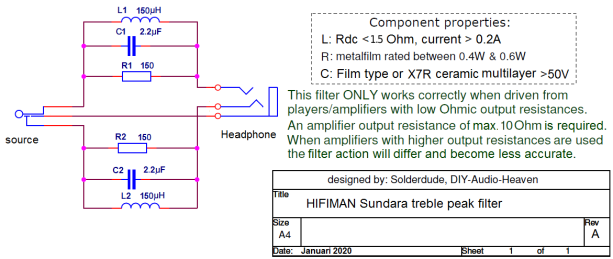
HIFIMAN Sundara 2020 filter

Below the filter schematic for the HIFIMAN Arya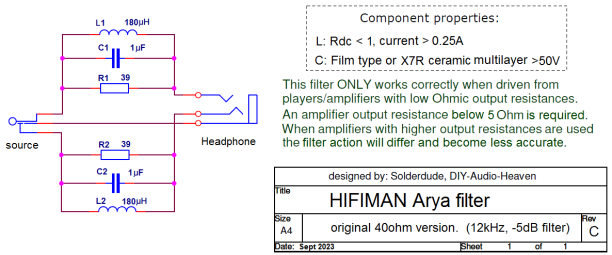
Below the filter for HIFIMAN RE-800

Below the filter for the NAD VISO HP50

Below the filter for 1More Triple Driver Over Ear Headphones.

Below the filter for Beyerdynamic DT1990 , DT1770 (when fitted with DT 770 pads) and Amiron Home

Below the filter for the Master & Dynamic MH40
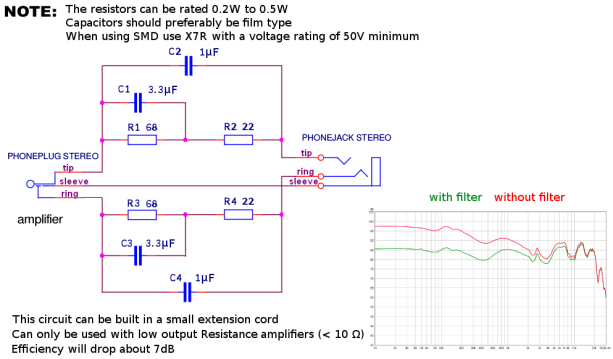
Takstar Pro82 (earlier version)

Below the filter for the Sennheiser HD58X and HD660S

Below the filter for the Sennheiser HD590

Below the filter for the Sennheiser HD800

Below the filter for the Sennheiser HD800S

Below the filter schematics for Beyerdynamic DT770 models
Different components are used for the different impedance models. Below the 4 different impedance filters below each other 32Ω (upper drawing), 80Ω, 250Ω and 600Ω below them.
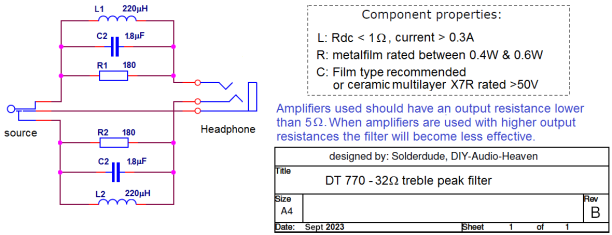

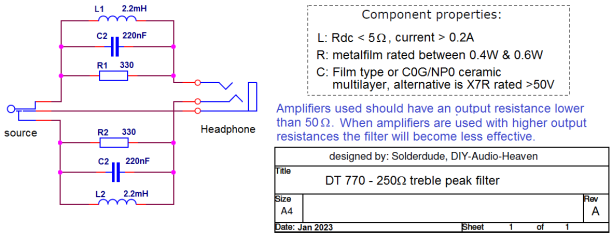

Below the filter for the Beyerdynamic DT880 Black Special Edition

Below the filter for the Beyerdynamic DT880 600Ω

Beyerdynamic DT990 Pro/250 filter
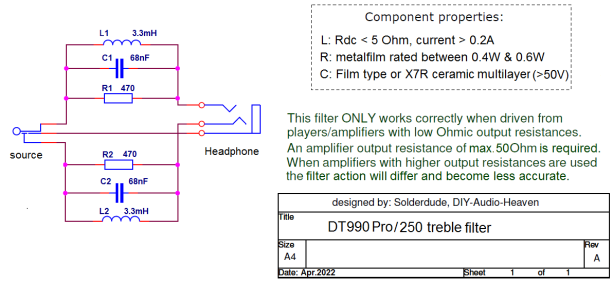
Below the filter for the AKG K712 / K7XX

Below the filter for the AKG K812
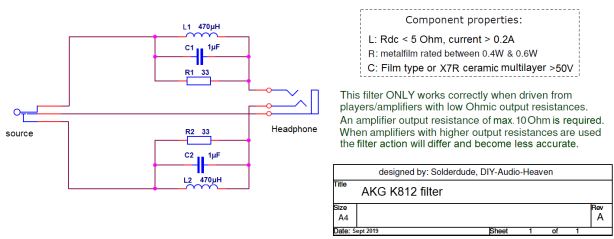
Below the filter for the AKG K601, K612

Below the filter for the AKG K701, K702

Below the filter for Grado SR60/80/125
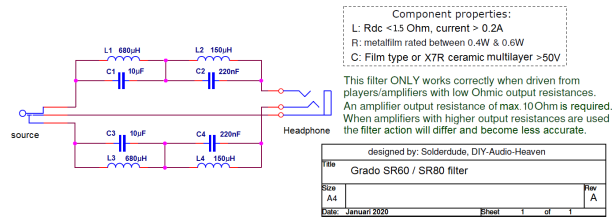
Below the filter for the AKG K371

Below the filter for the Audio Technika ATH-MSR7

Below the filter for the Philips Fidelio X2HR
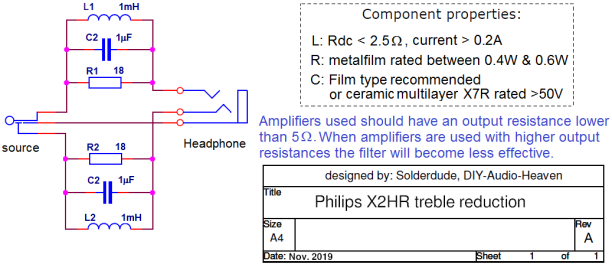
Below the filter for the Shure SRH840

Below the schematic for the HIFIMAN Edition XS

Below the filter for the Shure SRH-940

Below the filter for the Shure SRH1840

Below the filter for the Sennheiser HD560S

Below the filter for the Focal Utopia

Below the filter for the Yamaha MTH220

Below the filter for the Audeze Sine with Vesper Audio over ear pads

Below the filter for the Audeze LCD2 Closed Back.

Below the filter for the Audio Technica ATH-SR9

HIFIMAN HE560(v2) filter

Grado RS2e filter

Fostex TH909 filter

Pioneer SE-MS5T treble filter.

Superlux HD330 filter

Superlux HD660 Pro filter
The shown schematic values are only suitable for the 32Ω version,
The schematic is the same for the150Ω version but the inductor = 4.7mH, the capacitor = 68nF and the resistor must be 680Ω .

Sennheiser HD560 Ovation II and HD540reference II (Gold)

audio-technica ATH-A700X filter

Monoprice M1060 treble peak filter.

Shure SRH-440 treble peak filter and +4dB low bass boost. This all is at the expense of 12dB in sensitivity so this filter, unlike the other filters, will make the overall sound 12dB less loud (effectively lowering sensitivity from 119dB/V to 107dB/V.
This filter was custom designed and not tested/measured by me. The customer is satisfied with the results.

KZ AST bass/warmth reduction filter.

Sivga Phoenix and Sivga Robin treble reduction filter
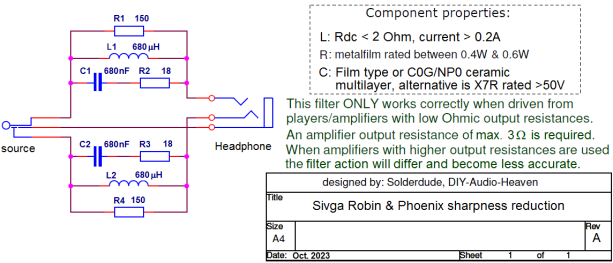

Hi
I would be interesred in a filter for the dt 1990 pro
3.5mm rean black gold jack and socket short version 20cm cable color does not matter.
Hello, I was wondering if it’s better to have a complete replacement of the stock cable or to just have a filter attached to the existing cable for DT1990 Pros?
Just received the filter for my DT 1990 Pro.
It really takes the edge off without affecting the detail and makes listening for hours finally possible.
Many thanks for making my DT 1990 shine again.
Every DT1990 owner should order a filter cable. It sounds just SO much better with the 7kHz peak attenuated. Longer listening sessions are way less fatiguing. Great service, quick delivery. Highly recommended!
I can only reinstate what others have said here. The DT1990, while being great headphones in almost every regard (I’m using them as my main headphone for studio use and critical listening), they never really grew on me. I’m quite treble sensitive, so the 8kHz spike was too harsh for me and the headphones ended up fatiguing me quite quickly.
I’ve ordered the filter cable from solderdude, got it within 3 days, it’s very much in line with the rest of the design, well-made and does exactly what it says on here. If you want to check out how the passive filter might affect your headphones and you want a taste test, for the DT1990 you can get really close with an EQ plugin in linear phase mode (I used FF Pro-Q3) and a 7-8db cut at 7.7kHz with a Q of 3-3.5. Really takes the edge off for me while still keeping the airiness and soundstage intact. Thanks a ton!
Great that you are sharing the schematics for DIYers. I have made one passive filter according this webpage. Thank you for this. I am not able to make measurements and provide may own schematics. But I can share with you my 3d model of enclosure for passive filter and cable splitter, it is available here: https://www.thingiverse.com/thing:5409040
Good usage of 3D printing. I would put the inductors as far away as possible.
Like so for instance:
hello I want to buy a filter for my dt 1990pro, thank you!
Hi solderdude, i realy apreciate your work. What do you use for the filter housings?
I use a steel curtain rod BUT as this has an influence on the inductors I use different values (or use different capacitors) to tune the filters so they filter at the correct frequency.
Then, once assembled but not yet covered with shrink tubing I measure and verify the desired operation.
When using the values as in the shown schematics one should use non metal enclosures (such as plastic).
Thank you